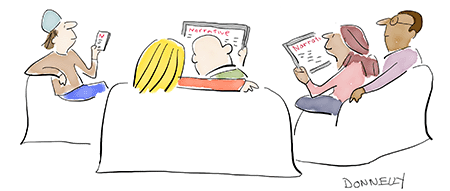by Rachel Mannheimer
Share
Forest Scene
This painter took his subject from Boccaccio’s Decameron.
With single-point perspective, the painting depicts a female nude,
terrified and fleeing amid systematically receding
trees. She’s pursued by dogs and a knight—the man who loved her
unrequitedly. He’ll slay her, then remove the heart and
circumjacent
parts and feed them to the dogs. Both nude and knight are ghosts
unrequitedly. He’ll slay her, then remove the heart and
circumjacent
parts and feed them to the dogs. Both nude and knight are ghosts
and doomed to reenact this scene each Friday. A circle, of sorts,
which often posed a problem for the painters. It’s dusk,
and the mountains fade blue in the distance.
which often posed a problem for the painters. It’s dusk,
and the mountains fade blue in the distance.
This is aerial perspective. Defined by da Vinci, it refers
to the depiction of the qualities of atmosphere and is unrelated
to his interest in flight—his sketches, for instance, of the
ornithopter,
to the depiction of the qualities of atmosphere and is unrelated
to his interest in flight—his sketches, for instance, of the
ornithopter,
modeled after birds. I went to Philadelphia to meet a man.
He cooked me breakfast and I took a nap on his couch.
We spent a lot of time looking out his empty window,
He cooked me breakfast and I took a nap on his couch.
We spent a lot of time looking out his empty window,
and at his handsome wall chart of the birds of North America,
so that, if you had spun the room like a thaumatrope,
you might have called this bird-watching or, perhaps,
so that, if you had spun the room like a thaumatrope,
you might have called this bird-watching or, perhaps,
a date. He was working on the future of travel—
passenger balloons that were powered by the sun and moved
along trajectories dictated by wind and atmospheric conditions.
passenger balloons that were powered by the sun and moved
along trajectories dictated by wind and atmospheric conditions.
He had a term for this: calculated submission. The scene of the
ghost hunt
was previously painted by Sandro Botticelli, and with greater
mastery. His painting was commissioned on the occasion of
a wedding,
ghost hunt
was previously painted by Sandro Botticelli, and with greater
mastery. His painting was commissioned on the occasion of
a wedding,
the source material chosen for the story’s happy end. Admittedly,
there’s more to the narrative. A frame. You wouldn’t be convinced.
Things were different then. They saw things differently.
there’s more to the narrative. A frame. You wouldn’t be convinced.
Things were different then. They saw things differently.



